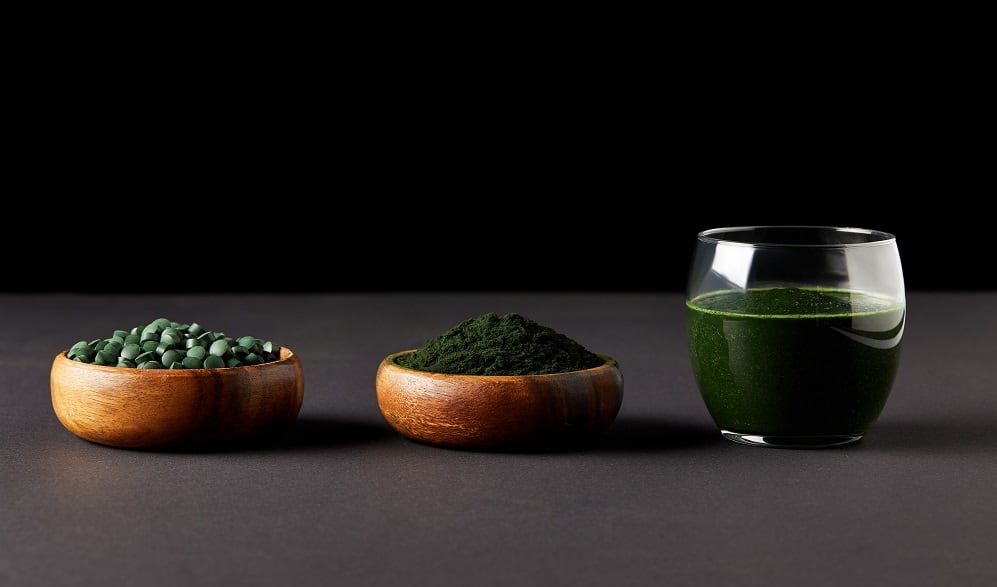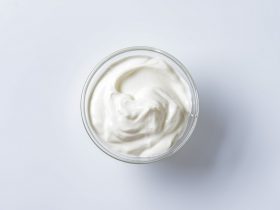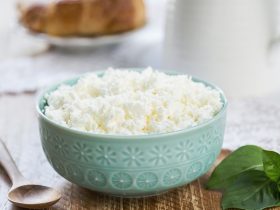Spirulina is a type of Cyanobacterium that grows both in fresh and salt water. It is also referred to as blue-green algae, and is often hailed as being a type of super food. It is composed of a lot of nutrients in extremely high amounts, hence it is also dubbed as possibly the “most nutritious food on the planet.”
While a number of health benefits of Spirulina is proven by scientific researches, safety of its consumption during pregnancy has not yet been established. Due to possible risk of contamination with toxins and heavy metals, it is recommended that pregnant women avoid intake of Spirulina.
What is Spirulina?
Spirulina is a microscopic, photosynthetic, filamentous microalga. Its name is derived from a Latin word that means tiny spiral. It is shaped like a spiral and is dark blue in color because of the presence of phycocyanin pigment (Sinha et al., 2018). It is more formally called Arthrospira, belonging to the phylum of Cyanobacteria with characteristic photosynthetic capabilities (Deng & Chow, 2010).
It grows naturally in subtropical and tropical areas of Asia, Central Africa, Mexico and America in high-salt alkaline water reservoirs (DiNicolantonio et al., 2020). Among its many varieties, the most commonly investigated species are Spirulina platensis, Spirulina maxima, and Spirulina fusiformis. These species are edible and have high nutritional and potential therapeutic values (Deng & Chow, 2010).
Spirulina is composed of a significant amount of proteins, vitamins, beta-carotene, minerals, polysaccharides, glycolipids and sulfolipids (Sinha et al., 2018). It also contains antioxidants, tocopherols, polyunsaturated fatty acids (PUFA), and phenolic compounds (DiNicolantonio et al., 2020).
It has been used as food for humans and consumed in many countries, including Germany, Brazil, Spain, France, Canada, United States, Ireland, Philippines, Argentina, India, and Africa. The cell wall of Spirulina is mainly composed of mucopolysaccharides and is devoid of cellulose, making it easily digestible. This makes it effective for people suffering from intestinal malabsorption, such as older people and children with Kwashiorkor (Sinha et al., 2018).
The World Health Organization (WHO) has called it the “food for the future” due to its high protein content and ability to grow rapidly, doubling its biomass every 2-5 days. It has also been called a “super food” or “wonder food” because it can boost the immune system and improve general health (Sinha et al., 2018). It is said to possess various positive biological activities, such as antiviral, antibacterial, antifungal, antiparasitic, antioxidant, and antiarthritic effects (Sinha et al., 2018).
Spirulina does not require fertile land to grow. It needs less energy and water input per kilogram compared to other sources of protein like soya and corn. Due to its being cost-effective and high in nutritional value, Spirulina has been used in protein-rich animal feeds and has been proposed as treatment strategy to prevent protein energy malnutrition (PEM) and protein energy wasting (PEW) in humans (Finamore et al., 2017).
Spirulina has been used in the treatment of nutritional deficiencies, malnutrition, immune enhancement, and iron deficiency anemia. Its supplementation during pregnancy and lactation has therefore gained the attention of researchers for its possible potential value that can ultimately benefit both mother and fetus (Sinha et al., 2018).
Spirulina was also recognized by the National Aeronautics and Space Administration (NASA) and the European Space Agency for food supplementation. They recommended consumption of Spirulina during long-term space travels due to its high nutrient density (DiNicolantonio, 2020).
Health Benefits of Spirulina

Malnutrition
The following populations are at greatest risk of malnutrition:
HIV patients
Ngo-Matip et al. in 2015 investigated the effect of Spirulina supplementation in HIV-infected individuals. They conducted a prospective study, including 320 participants randomized to either control group, who received local balanced diet and standard care, or treatment group, who received standard care plus 10 grams of daily Spirulina platensis supplementation for 6 months.
Their results showed that, after 12 months, there was a significant increase in CD4 cell counts and a significant decrease in viral load levels, as well as significantly higher hemoglobin levels and lower fasting blood sugar (FBS) concentrations, among patients in the treatment group. This proves that daily Spirulina supplementation combined with a balanced diet can improve immune functioning and delay disease progression among patients with HIV (Ngo-Matip et al., 2015).
Infants
Masuda & Chitundu (2019) hypothesized that daily Spirulina supplementation in infants less than 2 years old would increase their physical growth, reduce morbidity, and improve motor development. They made a randomized trial of 501 Zambian infants and followed them up over 12 months. The control group received a soya-maize based porridge while the treatment group received the same food supplemented by Spirulina.
After 12 months of intervention, the height and weight of the infants were statistically similar between the two groups, meaning Spirulina has no effect on physical growth. As to morbidity, infants in the Spirulina group were found to have lower risk of developing cough, pneumonia, and fever. Motor development was likewise improved in the treatment group, as seen in their higher probability of walking independently at 15 months (Masuda & Chitundu, 2019).
However, it was also noted by the researchers that the health effects seen may also be due to simultaneous supplementation with zinc and iron. Therefore, they cannot conclude that the reduction in infant morbidity was due to the Spirulina supplementation alone (Masuda & Chitundu, 2019).
Pregnant women
Many epidemiological and experimental studies suggest that nutrition during fetal development plays a role in maintaining energy metabolism in later life. The nutritional status of the pregnant mother strongly affects the development of a baby’s brain and cognitive abilities. Moreover, several reports demonstrate that malnutrition among pregnant women can alter the fetal genome and increase the risk of neurophyschiatric disorders, such as depression, schizophrenia, aggression, hyperactivity and anti-social behavior, in their offspring (Sinha et al., 2018).
Spirulina has gained special attention as a food supplement in pregnancy because of its availability, low cost, rapid growth, and high nutritive value. However, studies pertaining to the effects of Spirulina in maternal nutrition are almost always done in animals. Human studies are few and inconclusive.
Obesity and Dyslipidemia
Previous studies have shown that Spirulina contains the light-harvesting chromophore called phycocyanobilin that is capable of inhibiting NADPH oxidase, an important source of oxidative stress in adipocytes (fat cells). NADPH oxidase plays a key role in inducing insulin resistance and in development of obesity. The potential effects of Spirulina on weight loss and reduction in blood lipids, by suppressing adipocyte oxidative stress, were investigated by DiNicolantonio et al. in 2020.
In their review, they found that evidences suggest that Spirulina supplementation at 2-8 grams per day may improve lipid profile by reducing total cholesterol, triglycerides and low density lipoproteins (LDL), and improving high density lipoproteins (HDL). Spirulina was also found to help in weight loss and reduction of body mass index (BMI). Likewise, an improvement in insulin resistance, blood glucose levels and blood pressure have been noted (DiNicolantonio et al., 2020).
Likewise, Duran et al. in 2007 evaluated the effects of oral consumption of 4.5 grams per day of Spirulina maxima for 6 weeks to 36 men and women between 18 and 65 years old. They drew a sample of blood from each participant before and after intervention. Results showed that there were no significant changes in glucose and aspartate aminotransferase (AST), but total cholesterol, triglycerides, LDL and HDL cholesterols, as well as systolic and diastolic pressures were all improved.
However, effects of Spirulina on obesity and dyslipidemia are based largely on preclinical animal studies. According to Deng & Chow (2010), human clinical trials were limited in sample size and some have poor experimental designs. Therefore, our understanding on the effects of Spirulina on human consumption remain limited as well.
Similarly, Finamore et al. (2017) mentioned that the immunomodulating activity of Spirulina, its antioxidant and anti-inflammatory responses, are suggested by animal studies. But further investigations are required for confirmation in humans. In addition, they said that available human interventions used only Spirulina as supplements, and there are no data on Spirulina containing foods.
Is Spirulina Safe During Pregnancy?

Studies on Spirulina suggest that it is safe to consume by healthy subjects. It has been categorized by the Food and Drug Administration (FDA) under “generally recognized as safe” (GRAS) for human consumption. The Dietary Supplements Information Expert Committee (DSI-EC) also concluded that consumption of Spirulina poses no serious risk to health (Finamore et al., 2017).
Spirulina is viewed as a low cost nutritional source that has no established significant side effects (DiNicolantonio, 2020). Studies that do report side effects associated with its consumption are few and show uncertain causality.
Among these side effects are insomnia, gastric problems, rhabdomyolysis, anaphylaxis, autoimmune mediated skin damage, and hepatotoxicity. Some drug interactions have also been reported. Hence, Spirulina was recommended to be ingested with caution in individuals with diseases like hypertension, and those being treated with immunosuppressants and lipid lowering drugs (Finamore et al., 2017).
During pregnancy, the benefits of consuming Spirulina are still in question. Experts are not in agreement on its safety due to the limited studies conducted in humans and pregnant women. However, due to the possible risk of contamination with toxins and heavy metals, it is recommended that pregnant women avoid the intake of Spirulina.
Possible Risks from Spirulina Consumption
Although Spirulina is considered generally safe, there are still potential risks from its consumption. These include the following:
Toxins
Spirulina has the potential risk to be contaminated with toxins and other bacteria. Some toxins associated with cyanobacteria may be potent and harmful to animals including humans. These cyanotoxins are generally divided into liver toxins, neurotoxins and dermatoxins (Miller et al., 2017).
Microcystins are some of the most toxic and prevalent toxins produced by cyanobacteria in both fresh water and salt water algal blooms worldwide. Both acute and chronic exposures to microcystins are known to cause hepatotoxicity (McLellan & Manderville, 2017). However, toxicity has also been reported in the kidney, lungs, and other cells of the human tissues, probably from induction of vascular inflammation in human endothelial cells (Shi et al., 2015).
Mercury and Other Heavy Metals
Spirulina that has been harvested in the wild is a big concern as this increases the risk of contamination with mercury and other heavy metals. Prenatal exposure to heavy metals has shown deleterious effects on infant birth weight (Sabra et al., 2017). Mercury is a known neurotoxic chemical, and its exposure to pregnant women has been linked to lower cognitive performance in their offspring during childhood (Cardenas et al., 2017).
Certain Disorders or Conditions
Individuals with certain diseases should verify with their doctors regarding the safety of their exposure with Spirulina. Phenylketonuria is listed as a contraindication to intake of Spirulina, but it has not yet been validated. Spirulina reduces blood clotting, hence it can increase the risk of bleeding and bruising in people with bleeding disorders.
People with diabetes mellitus should be careful and monitor their blood sugar when taking Spirulina, as it may lower blood glucose levels. It could also worsen symptoms in people with autoimmune diseases, such as systemic lupus erythematosus (SLE), multiple sclerosis, and arthritis.
Moreover, medications for these disorders may interact with Spirulina and can affect their efficacy in managing these conditions. Hence, these individuals should confirm with their medical specialists if it is safe for them to take Spirulina.
Pregnancy and Lactation
The specific risks and side effects of Spirulina intake during pregnancy and lactation are unknown. More studies are needed to be conducted in humans and in pregnant and lactating women before recommendations can be specified for this population.
It is important to note, though, that unborn babies are at greater risk for the potential dangers of Spirulina contamination than adults. Because of possible presence of mercury and toxins, it is best to avoid Spirulina throughout pregnancy. Pregnant women should speak with their health care providers about the best nutritional supplement for their needs.
Final Judgment
Spirulina is generally considered safe for human consumption as seen through its long history of use as food source as well as its acceptable safety profile in animal studies. However, there have been reports of rare cases of side effects. There is also the concern about the process of growth of Spirulina and the possibility of contamination with heavy metals, other bacteria, and certain toxins.
Because of the limited studies in humans and in pregnant women, the use of Spirulina as part of the diet of pregnant women or as a nutritional supplement cannot be recommended. Health care providers and physicians must be consulted to ensure no harm to the pregnant mother and her unborn baby.
References
https://www.drugs.com/npp/spirulina.htmlhttps://www.webmd.com/drugs/2/drug-168671/blue-green-algae-spirulina-bulk/details/list-precautionshttps://www.webmd.com/diet/spirulina-health-benefits#2-5Cardenas, A., Rifas-Shiman, S., Agha, G., Hivert, M., Litonjua, A., DeMeo, D., Lin, X., …, & Baccarelli, A. (2017). Persistent DNA methylation changes associated with prenatal mercury exposure and cognitive performance during childhood. Scientific Reports 7, 288. doi: 10.1038/s41598-017-00384-5Deng, R., & Chow, T. J. (2010). Hypolipidemic, antioxidant and antiinflammatory activities of microalgae spirulina. CardiovascularTherapeutics 28(4), e33-e45. doi: 10.1111/j.1755-5922.2010.00200.xDiNicolantonio, J., Bhat, A., & OKeefe, J. (2020). Effects of spirulina on weight loss and blood lipids: A review. Open Heart 7(1), e001003. doi: 10.1136/openhrt-2018-001003Duran, P., Hermosillo, A., & Oropeza, M. (2007). Antihyperlipemic and antihypertensive effects of Spirulina maxima in an open sample of Mexican population: A preliminary report. Lipids in Health and Disease 6, 33. doi: 10.1186/1476-511X-6-33Finamore, A., Palmery, M., Bensehaila, S., & Peluso, I. (2017). Antioxidant, immunomodulating, and microbial-modulating activities of the sustainable and ecofriendly spirulina. Oxidative Medicine and Cellular Longevity 2017, 3247528. doi: 10.1155/2017/3247528Masuda, K., & Chitundu, M. (2019). Multiple micronutrient supplementation using Spirulina platensis and infant growth, morbidity, and motor development: Evidence from a randomized trial in Zambia. PLoS One, 14(2), e0211693. doi: 10.1371/journal.pone.0211693McLellan, N., & Manderville, R. (2017). Toxic mechanisms of microcystins in mammals. Toxicology Research 6(4), 391-405.Miller, T., Beversdorf, L., Weirich, C., & Bartlett, S. (2017). Cyanobacterial toxins of the Laurentian Great Lakes, their toxicological effects, and numerical limits in drinking water. Marine Drugs 15(6), 160. doi: 10.3390/md15060160Ngo-Matip, M., Pieme, C., Azabji-Kenfack, M., Moukette, B., Korosky, E., Stefanini, P., …, & Mbofung, C. (2015). Impact of daily supplementation of Spirulina platensis on the immune system of naïve HIV-1 patients in Cameroon: A 12-months single blind, randomized, multicenter trial. Nutrition Journal 14, 70. doi: 10.1186/s12937-015-0058-4Palmery, M., Bensehaila, S., & Peluso, I. (2017). Antioxidant, immunomodulating, and microbial-modulating activities of the sustainable and ecofriendly spirulina. Oxidative Medicine and Cellular Longevity 2017, 3247528. doi: 10.1155/2017/3247528Sabra, S., Malmqvist, E., Saborit, A., Gratacos, E., & Roig, M. D. (2017). Heavy metals exposure levels and their correlation with different clinical forms of fetal growth restriction. PLoS One, 12(10), e0185645. doi: 10.1371/journal.pone.0185645Shi, J., Zhou, J., & Zhang, M. (2015). Microcystins induces vascular inflammation in human umbilical vein endothelial cells via activation of NF-ĸB. Mediators of Inflammation 2015, 942159. doi: 10.1155/2015/942159Sinha, S., Patro, N, & Patro, I. (2018). Maternal protein malnutrition: Current and future perspectives of spirulina supplementation in neuroprotection. Frontiers in Neuroscience 12, 966. doi: 10.3389/fnins.2018.00966




